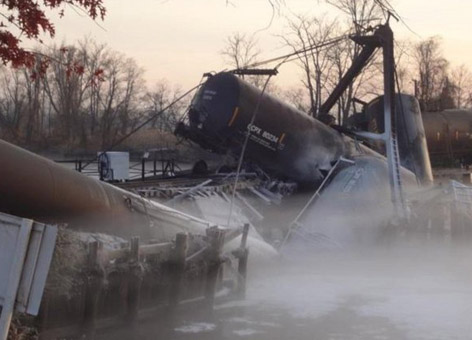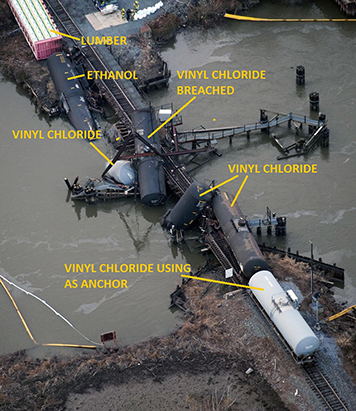A Train Derails in Paulsboro, N.J., Releasing 23,000 Gallons of Toxic Vinyl Chloride Gas

UPDATED DEC. 17, 2012 — Recovery operations are now complete for the derailed train cars carrying vinyl chloride. On Nov. 30, 2012, a train transporting the chemical vinyl chloride derailed while crossing a bridge that collapsed over Mantua Creek, in Paulsboro, N.J., near Philadelphia. Four rail cars fell into the creek, breaching one tank and releasing approximately 23,000 gallons of vinyl chloride. Local, state, and federal emergency personnel responded on scene. A voluntary evacuation zone was established for the area, and nearby schools were ordered to immediately take shelter and seal off their buildings.
Vinyl chloride, which is used to make plastics, adhesives, and other chemicals, is a toxic gas. During this accident, most of the chemical was released directly to the air, and response teams worked to determine how much might have dissolved in the creek's waters, which feed into the Delaware River. U.S. Coast Guard Sector Delaware Bay contacted NOAA's Office of Response and Restoration (OR&R) and requested scientific support for this environmental and public health threat.
The OR&R scientific support team helped address early concerns about the air hazard, centering around possible health effects, evacuation decisions, proper protective equipment for responders, impacts to the Philadelphia airport two miles away, and reactivity between vinyl chloride and another rail car containing ethyl alcohol. OR&R develops software products responders use to address these issues: ALOHA, an air dispersion model, and CAMEO Chemicals, a hazardous material database.
OR&R had a Scientific Support Coordinator (SSC) at the scene of the spill to work with the Coast Guard as they attempted to salvage the derailed cars from the creek and collapsed bridge. While the SSC departed on Dec. 6, a NOAA incident meteorologist remains at the incident command post to provide custom weather forecasts for the affected area, for air monitoring and to identify safe operating conditions for the crane work and other salvage operations.

OR&R's Emergency Response Division also was involved from NOAA's Seattle offices, where they investigated potential problems in case the vinyl chloride accidentally were discharged into the water during salvage operations. In addition, two scientists from NOAA's Center for Operational Oceanographic Products and Services (CO-OPS) had been dispatched to Paulsboro to deploy a current meter and forecast the tides specifically for Mantua Creek (which is driven by tidal flows) to schedule safe crane and dive operations. To help the National Transport Safety Board's investigation into this incident, CO-OPs scientists also will recreate the tidal cycle conditions during the time of the incident.
Removing the derailed train cars proved to be a logistically complicated process. First, the Coast Guard coordinated the removal of the last 600 gallons of vinyl chloride from the breached tank by using acetone and suctioning out the vapors before attempting to move the tank. Next, the response team successfully brought in cranes and barges to remove the rail cars from Mantua Creek, re-establish them on the rail, and have them transported away from the site. Recovery operations for the derailed train cars ended on December 17.
